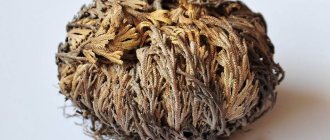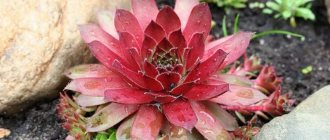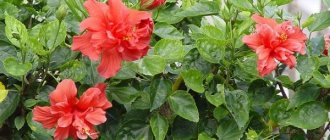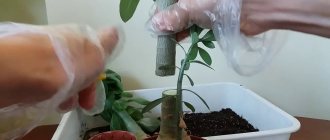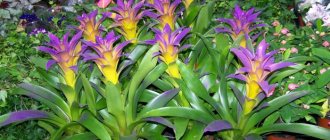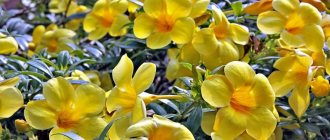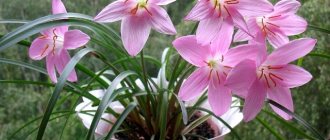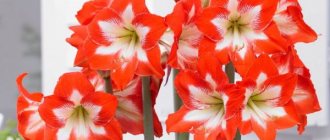Rose of Jericho is native to the Middle East. The botanical name is Anastatica Jericho, derived from the ancient Greek words for “again” and “revitalized.” According to legend, the Virgin Mary saw this plant on her way to Egypt and blessed it with eternal life. Hence another name - Egyptian rose.
This herbaceous plant is capable of growing in such harsh conditions where most plants die. How to grow the Rose of Jericho and how to care for it at home - later in this article.
Feature of the plant
The life cycle of this rose goes very quickly. It starts growing in the spring, quickly begins to bloom and set fruit. Her flowers are white, small, inconspicuous. Seeds are produced in pods.
The peculiarity of this plant is that when there is a lack of moisture, it gradually curls towards the center and dries up, hiding the fruits in the middle of the ball. Having turned into a tumbleweed, it begins to look for new habitats, taking with it the same balls along the way.
They move like this until the rain stops them. After watering, the rose comes to life, straightens, and seeds spill out of it, which quickly germinate in a humid environment.
Also, during its movement across the territory, these grains fall out and germinate under favorable conditions along the entire route. Soon the seedlings produce white buds, which again set seeds that can remain viable for a long time.
Important! The dried Rose of Jericho does not come to life, but releases seeds from the ball, which germinate. They can germinate even while in the mother plant.
It is often confused with Silaginella lepidoptera, which does not bloom and reproduces by spores. It is she who awakens in humid conditions and goes to rest during drought. Those who have never seen what these balls look like when opened may confuse them. They can be distinguished by their root system:
- Anastatic has a tap root;
- in Silaginella it is fibrous.
Contraindications and side effects
To date, scientists have not conducted much research on the safety of rose of Jericho, whether taken orally or applied to the skin.
Applying Rose of Jericho directly to the skin has no known risks, but it is best to avoid applying it to open cuts or wounds.
If you have diabetes, low blood pressure, high blood pressure, or other metabolic disorders, be sure to talk to your doctor before taking rose of Jericho to lower your blood sugar and blood pressure.
In addition, Rose of Jericho is a folk remedy for inducing labor, so you should consult your doctor before taking it. There is currently insufficient evidence of its safety.
If you have already taken rose of Jericho to induce labor, tell your doctor. It may affect the medications you take during labor. Unfortunately, there are no studies on its potential drug interactions (10).
If you want to take rose of Jericho, talk to your doctor first, especially if you are pregnant or have a medical condition.
Conclusion:
Use caution when taking rose of Jericho during pregnancy, as there is limited research on its safety and because anecdotal reports say it may induce labor. If you are taking medications or have a medical condition, talk to your doctor first.
Growing
At home, Anastatica does not feel very good, especially in winter, when radiators dry out the air greatly. It needs to be provided with high humidity. To do this, place the pot with the plant in a tray filled with expanded clay, pebbles, and sphagnum moss. The fillers are constantly moistened with water.
A good option would be to keep it in a florarium. Under these conditions, humidity will be constantly maintained at the level required by the bush, which is difficult to ensure in an open container.
Rose of Jericho in the florarium
Rose of Jericho is a shade-tolerant plant, so it will feel good on the windowsill of a north window. When growing it on the south side of a house or apartment, the windows are slightly shaded.
Anastatica comes from an arid climate and can grow in open areas only in the deserts of Asia and Africa. Climatic conditions with alternating winter and summer and dry air do not allow it to be grown in temperate latitudes.
Note! In flower shops, under the guise of the Rose of Jericho, they often sell Silaginella squamosus. It is she who, when coming to life, produces new shoots: she does not reproduce by seeds, since she does not have them.
General information
This extraordinary species of miniature plants with carved leaves cannot be classified as ferns or flowering species; they are classified as club mosses, which are an older group of plants.
The branches of this species are covered with numerous small leaves, which are similar to flat needles; they very often overlap each other like tiles.
When growing and caring for Selaginella at home, as a rule, the plant does not have enough air humidity, for this reason it is much better to grow them in florariums, bottle gardens, greenhouses or closed flower displays. In culture, these plants are used as soil cover plants or epiphytes.
Most often in indoor floriculture you can find Selaginella Martens - this plant is a soil cover plant with erect stems reaching up to 30 centimeters in length and aerial roots. The leaves are light green in color, and the watsoniana variety has silvery stem tips.
Planting and caring for the rose of Jericho
How does Anastatica plant and propagate indoors? To do this, follow these steps:
- Warm, settled water is poured into a shallow pan;
- the dried ball is laid out with the roots down;
- when it opens, green shoots begin to grow from the core due to the seeds hidden in the depths of the ball.
The entire plant can be planted in a pot filled with soil consisting of sand and pebbles, or the plants can be separated into individual containers. Periodically, the bush can be fed with complex fertilizer, much more diluted with water than for other plantings.
Planting the Rose of Jericho
The optimal temperature for keeping roses is +20°C. The location should be slightly shaded. Several times a day it must be sprayed with warm, settled water. Watering is done as the substrate dries.
In dry air conditions, the planting may be attacked by spider mites. To get rid of it, the bush is washed with soapy water. If kept in a humid environment for too long, it can become infected with a fungal disease. To get rid of it, the rose of Jericho is sprayed with a fungicide.
The bush needs to be given a period of rest: stop watering and spraying. The rose does not have any special requirements for wintering. You can store it in any dry place.
Feeding and replanting
The soil should be fed monthly. You can use nitrogenous fertilizers. Once every two years (in spring), the rose of Jericho requires replanting to improve growth.
It must be said that the plant is resistant to various diseases and pests. Its only enemy is dry air, which can provoke the development of spider mites. A regular soap solution will help get rid of it.
The plant is propagated by green cuttings. To do this, in early spring, plant them in a small greenhouse and place it in the shade. The cuttings will take root in two weeks.
Silaginella squamofolia
Because the store sometimes sells silaginella squamofolia under the name Rose of Jericho.
It is displayed for sale in the same way as anastatica, rolled up into a ball. When placed in a humid environment, silaginella opens up and the leaves gradually turn green, with a beautiful emerald hue. It can be grown in soil with the addition of sand, sphagnum moss and peat.
In nature it grows up to 10 cm in height, at home even less. Its diameter is about 40 cm. Silaginella has delicate leaves, giving it a fluffy appearance. It has this appearance during the rainy season; in hot weather the branches curl into a ball.
Kinds
There are several types of Rose of Jericho, so it is important to know their differences before deciding what kind of care a particular plant needs.
The most common type is Martens rose. It has erect stems that can reach a length of thirty centimeters, but gradually they become lodging. Its branches are slightly reminiscent of ferns, but the tips of the leaves are silvery-white in color.
Selaginella squamofolia has stems that do not grow more than ten centimeters in length. If the humidity in the room is insufficient, they curl into a ball, but as soon as the plant is watered, it immediately comes to life and scatters its leaves.
Symbolism and virtues of the rose
Silaginella squamosal is a symbol of longevity and resurrection.
- This is a long-lived flower, so it can be inherited as a symbol of the family.
- It is customary to give it on the day of the Resurrection of the Lord, as a reminder that after death the resurrection of the soul will come.
- The dried ball is given to each other by lovers, placed inside the ring. When the flower opens, the rings are taken out.
- When placing a rose inside a cabinet, it will repel moths.
- The bush thins out the light aroma of meadow herbs, so it is used as a natural air freshener.
- Disinfects the air from harmful microorganisms and absorbs tobacco smoke.
- The mechanism of opening and closing branches may be interesting for children.
Additional Information! In the story “The Rose of Jericho,” I. Bunin talks about a legend that says that the name of the flower was given by the Monk Savva when he was in the Judean desert.
The bush does not come to life in the literal sense of the word; dried shoots do not become green again, as flower catalogs sometimes promise. When placed in a humid environment, they open, and the seeds remaining inside begin to turn green. But even the process of opening and closing branches is interesting to observe.
| Category: | Plants |
| Published by: beregreki, viewed: 3,868 | QR code page
Resurrection plant Rose of Jericho, Selaginella Lepidoma, Selaginella Lepidophylla, Rose of Jericho.
This plant can remain alive without water for up to 50 years.
It needs very little water. Without water, selaginella curls into a tight ball, but unfolds and grows after watering. The process can be repeated endlessly.
The Chihuahuan Desert, which straddles the US-Mexico border.
Selaginella lepidophylla is a desert, perennial, shade-loving plant that has existed for about 290 million years. Dry persists for decades, so it can be passed on from generation to generation. Sometimes a gift, such as a ring or necklace, is placed in the open Rose of Jericho and then allowed to close. As soon as the rose is placed in water, it reveals its secret.
Place the rose in a bowl, pour in some water and witness the magnificent natural miracle of the awakening of Jericho. Within an hour it will turn green, and its shade will depend on the water temperature.
The Rose of Jericho also has practical usefulness.
When wet, it absorbs tobacco smoke, humidifies and improves the air. Dry, destroys pests in the place where it is stored (for example, moths in a closet).
It usually grows on rocks or dry soil in deserts. Under such conditions, most other plants will die, while the Rose of Jericho survives and manages to grow. When the soil is dry, the plant cannot store water, such as cacti. In this case, the stems are formed into a ball to retain some moisture in the center.
All metabolic functions are reduced to a minimum, and the Rose of Jericho appears to be a dry and dead tuber.
In fact, this plant can remain in this state for up to 50 years. When the rains begin, its cells are moistened, the plant straightens its stems and opens in full. Her metabolism increases and she regains her height.
Pour 1 cm of water into the thicket and place Selaginella in it;
The temperature of the water will determine the intensity and shade of the green color; In 60-90 minutes it will bloom;
Add water daily so that the roots are completely submerged;
Do not keep the Rose of Jericho in water for more than seven days at a time, otherwise it will rot;
After this period of being in water, the plant needs a period without water; To do this, remove the plant from the water and keep it dry for at least 2 weeks. If your Rose becomes infected with mold, buy a fungicide, dissolve a few drops in half a liter of water, and spray the resulting solution on the Rose of Jericho.
Dry Selaginella can be stored in a closet as it prevents the proliferation of parasites. You can decorate a decorative terrarium, a pot filled with pebbles, shells, dried flowers or other decorative material with a rose.
Rose of Jericho does not require:
– Care – Fertilizers – You can calmly go on vacation and not worry about the fate of the plant – Planting in the ground and appropriate feeding with fertilizers, transplants, etc. – Rose of Jericho is a very interesting flower for children – An interesting element for interior decor
Place the rose in a bowl, pour in some water and witness the magnificent natural miracle of the awakening of Jericho. Within an hour it will turn green, and its shade will depend on the water temperature
.
Do you prefer to read on your phone or tablet? Then scan this QR code directly from your computer monitor and read the article. To do this, any “QR Code Scanner” application must be installed on your mobile device.
Review: Houseplant “Rose of Jericho” – I’ve never seen anything like it before.
Home rose: types, planting, care at home
We bought these multi-colored dry lumps at the market during our next trip to Egypt
Before this, we went for several years, but never paid attention to them, or maybe they weren’t there before. It turns out that this is a dried plant, painted by local merchants with paints of different colors.
These flowers are sold in huge baskets right on the street. The choice of colors and sizes is huge, there are unpainted specimens. The price depends on the size of the flower and the ability to bargain. We bought 5 flowers (2 were given as gifts) for $2.
The flower is called the rose of Jericho. The Egyptians call it “the hand of the Virgin Mary” or “the hand of the Prophet.” According to legend, the Virgin Mary, on her way to Egypt, saw this flower in the desert and predicted a life with many resurrections for it. And indeed the rose of Jericho lives for about 30 years. During this time, it can dry out many, many times without water and bloom again when immersed in water for 1-2 hours. It will be interesting for children to watch this process, especially if they “have a hand in it.” The scientific name of the flower is Anastatica Jericho, and it is the only representative of this genus. It grows only in hot, arid deserts where rain is rare. And people call it tumbleweed. When a plant's leaves fall, the woody stems shrink into a tight ball and straighten out when immersed in water. You can find seeds inside and germinate them in the ground as usual. The locals have this custom. Inside the flower that is beginning to dry up, men hide a gift for their beloved, usually a ring, and give this rose of Jericho as a surprise. When dried, lignified branches are almost impossible to open. And in the water the rose blooms and “presents” a gift.
There is a belief that such a rose brings peace and tranquility to the house and gives happiness to all its inhabitants.
Here I put 3 dried flowers in a vase with water. Water volume 2 liters.
2 hours passed. The rose begins to bloom. Inside the flower, on the unpainted parts, I found several seeds and planted them.
Gradually the flowers increased in size and filled almost the entire vase. Our whole family goes and follows the process. Very interesting. The first time the water became a little stained, I changed it. It is recommended to change the water about once every 10 days. The photo shows that the vase is a little fogged up from cold water, which means you need to pour warm water.
Where should I put this flower? Maybe to the TV on a black background? In my opinion, not very much. Boring.
I decided to put it in a bright place on the dining table. Not bad. Unusual. Everyone is interested in what it is.
She put inside a magnet from the same Egypt with the inscription “Red Sea”. The fish look really good here.
Another day later my rose has grown a little, the vase is becoming small. Branches are already visible above the surface of the water. You need to take a larger vase. I also added shells from the Black Sea to the vase.
This is what a desert flower, rose of Jericho, Black Sea shells and an ordinary magnet look like together. Maybe tomorrow I'll come up with something else. And now it looks like this:
Description.
This plant, despite its name, is practically nothing like an ordinary rose. Instead of a strong stem with thorns there is a tangle of stems, instead of a large flower there are many small white flowers. Scientific name - Anastática hierochuńtica (from Latin). Refers to a type of small annual herbaceous plants.
Family – Brassicas (Brassicaceae). The Rose of Jericho is the only representative of the Anastatica genus. “Anastatic” is from the Greek “to resurrect”, “again”, “again”, “to make alive”, by the way, from which the name Anastasia comes. In Egypt, this plant is called the hand of the Virgin Mary.
Several other plants are also called rose of Jericho:
- Selaginella squamosal is a plant of the genus Moss club.
- Asteriscus dwarf is a plant of the Asteraceae genus.
They are similar to the real rose of Jericho in appearance, life cycle and interesting properties, but they are not real roses of Jericho - and not even close relatives. At the same time, the methods of caring for Selaginella and Astericus are similar to caring for Anastatica - after all, all three of these plants develop and hide from drought according to the same principle.
Growing problems, diseases and pests
Most often, the Egyptian rose becomes infected with fungal diseases. To avoid this kind of problem, you should periodically treat the plant with fungicides. To prevent the flower from rotting, the condition of its inflorescences must be monitored especially carefully. The formation of mold is strictly prohibited.
If you take good and proper care of a flower brought from Egypt, it will practically not hurt.
There are situations when spider mites appear on a dry rose. You can cope with the problem using a solution of laundry soap. These pests appear as a result of being in a room with dry air.
Important! After the life cycle, the plant requires a period of rest, which must be carefully ensured. You can prepare a flower for the dormant period in the fall by stopping watering it and reducing the humidity. As a result, the rose will take the shape of a ball, which can be stored in a dark place until spring.
Asteriscus dwarf
The exquisite and amazing rose of Jericho is rightfully considered an amazing plant that can exist for a century without water and then be reborn in just one day when moisture is supplied. Despite its name, the flower has absolutely no external resemblance to the usual rose. In nature, the plant travels across endless sands, attracting the attention of plant growers for many centuries. At the same time, it still remains a mystery how a plant can be lifeless, and then, when interacting with water, so quickly revive and bloom.
Hot chocolate capsules Nescafe Dolce Gusto Chococino, 8 servings
334 ₽ More details
Nesquik Opti-Start instant cocoa drink, 250 g (package)
125 ₽ More details
Green table lamps
Geography
Jericho roses grow in the deserts of Western Asia and North Africa, with the exception of selaginella, which is “original” from Mexico and the southern United States, primarily Texas.
The harsh conditions of existence “taught” her to adapt to prolonged heat and drought. When there is enough water, it looks like a bush with small white flowers. By the way, the rose of Jericho belongs to the Cabbage family and is therefore a distant relative of cabbage and kohlrabi, as well as horseradish and radish.
Application and dosage
People most often use the rose of Jericho as an ornamental plant and in various spiritual rituals. Many people believe that she:
- “Resurrects” areas of your life
- Brings good luck
- Protects you from negative energy or situations
In folk medicine, people most often consume it in the form of tea.
Only a few commercial products are available. That's why most people make it at home by buying dried rose of Jericho "flowers", which are actually small bunches of the plant.
Some unreliable sources claim that you can add 1 tablespoon (about 2 grams) of dried leaves or flowers to boiling water and let it steep for about 5 minutes. However, you can use smaller quantities at first.
Few skin care companies sell products containing rose of Jericho, which can make it difficult to obtain a skin care product that contains it. Additionally, there are no reliable recommendations for making any skin care products at home.
It is important to note that many products containing rose of Jericho actually contain false rose of Jericho (Selaginella lepidophylla). So, if you are looking for the real version, look for the name Anastatica hierochuntica or A. hierochuntica on the product label.
Conclusion:
People most often buy rose of Jericho in the form of dried leaves or flowers and prepare it as a tea. However, if you are looking for a true Rose of Jericho, make sure the label says Anastatica hierochuntica or A. hierochuntica.
Life cycle
Mary's hand grows in early spring, when there is enough water in the desert. The leaves grow quickly, the plant blooms and bears fruit. In summer, during periods of heat and lack of moisture, the leaves dry out and form a dry “ball”. With gusts of wind, this “tumbleweed” blows across the desert, sometimes scattering, sometimes sticking together with other lumps, in search of water. When there is a hollow or a place after rain, the Jericho rose immediately blooms and pours out seeds. They remain viable for several years.
It must be said that when dried, the Rose of Jericho does not begin to rot. She comes alive in the water. But, if you dry the plant again, it will simply become a small ball.
Dried rose of Jericho
Site selection and soil preparation
Jericho roses go on sale in the form of intertwined clumps formed by dried shoots.
To observe the amazing “resurrection” of a flower, you must:
- choose a shaded place in the room, away from sunlight and heating devices;
- place the “ball” in a bowl with a little water (no more than 2 cm), and after 24 hours, when the exotic blooms, move it to a container with sand with the addition of a small amount of pebbles.
This plant does not need fertilizers or any additional feeding, which is its undoubted advantage.
Important! The rose should only be placed in warm water.
Where is the Rose of Jericho used?
The plant also has wide practical applications. Even in Egypt, it was used to improve sleep quality . Also, the Rose of Jericho can protect the house from household pests . For example, if you put a plant in a closet, it will help fight moths. When moist, Egyptian Rose absorbs tobacco smoke , purifies and improves indoor air.
The Egyptian plant is good to watch with children. The plant in this case is a living creature that can be “put to sleep” and then, a month later, awakened to life again.
Grown as an ornamental plant. The rose of Jericho is used for decorating and “wrapping” gifts , so to speak. A gift, such as a necklace or ring, is placed inside the plant. The plant dries up and retains the gift inside itself. But as soon as the plant is placed in water, it reveals its secret.
Use in landscape design
Designers sometimes use the rose of Jericho to decorate a rock garden because it does not require soil. But, as a rule, it is used for landscaping indoor environments.
Application of rose:
- acts as a humidifier, saturating the air with oxygen;
- is a natural freshener: fills the room with spicy aromas;
- used for growing in an aquarium and decorating other artificial reservoirs;
- disinfects the air, killing harmful microorganisms that cause various diseases;
- absorbs tobacco smoke;
- in the dormant stage destroys moths;
- thanks to its specific properties, it prevents allergic attacks;
- helps fight insomnia, ensuring sound and healthy sleep.
The Rose of Jericho is a unique plant that, although it bears no resemblance to the queen of our flower gardens, is a truly impressive plant. Moreover, caring for an extraordinary flower at home is possible even for people who have not previously grown indoor crops.
attuale.ru
Plant in myths, poems and history.
In Egypt, poems were dedicated to this plant; it was also believed that the flower helps during childbirth. And as an indoor plant that does not require special care, the Rose of Jericho has many fans all over the world.
At one time, the Spanish colonialists used the Rose of Jericho to show the Indians what resurrection was. In general, there are a lot of near-religious legends about this plant. The most beautiful of them says that when the Mother of God went with the baby Jesus Christ and Joseph the Betrothed to Egypt to escape the beating of infants by Herod, she saw this plant and blessed it. After this, it became a symbol of the resurrection of Christ.
To this day, the Rose of Jericho is used in Easter festivities in the Christian Middle East. However, it is possible that this belief originated from the devout crusading knights who first saw the Rose of Jericho on the dusty roads of the Middle East.
And according to popular belief, the rose of Jericho brings a long-awaited baby to the house - that is, it helps against infertility. Whether this is true or not, we don’t know (most likely, speculation), but the fact that it perfectly absorbs smoke, harmful substances and odors is, as they say, a “medical fact.”
Potential medicinal properties
Rose of Jericho humidifies the air in the room and serves as a natural freshener, as it emits the aroma of steppe herbs. The plant has bactericidal properties and disinfects the air. In addition, it absorbs tobacco smoke. If a flower is placed in the bedroom, it will promote better sleep. In dried form, the annual can be used to combat moths in the closet.
Rose of Jericho is a very interesting and spectacular plant. With proper care, it will delight you with its exotic beauty.
Rose of Jericho is native to the Middle East. The botanical name is Anastatica Jericho, derived from the ancient Greek words for “again” and “revitalized.” According to legend, the Virgin Mary saw this plant on her way to Egypt and blessed it with eternal life. Hence another name - Egyptian rose.
This herbaceous plant is capable of growing in such harsh conditions where most plants die. How to grow the Rose of Jericho and how to care for it at home - later in this article.
There are many health claims made about rose of Jericho, but little research has been done to back it up.
It contains disease-fighting plant compounds known as flavonoids. Specifically, it's rich in chlorogenic acid, quercetin, kaempferol, and luteolin, which studies have shown may reduce inflammation, arthritis pain, blood pressure, and blood sugar (2, 3, 4, 5).
Despite this, researchers do not have enough evidence to say whether rose of Jericho tea or other forms of rose contain enough of these compounds to provide a therapeutic effect. Scientists need to conduct more research on the effects of the rose of Jericho on human bodies.
For example, most studies on quercetin have shown that it can have beneficial effects at doses of 500 mg or more. However, rose of Jericho contains less than 50 mg of quercetin per gram, so it may not be a good source of this compound (5, 6, 7, 8).
Along with this, some people think that Rose of Jericho has anti-aging properties due to its high levels of antioxidants. However, there are no studies available to support its use in skin care products.
Finally, Rose of Jericho is known for its use as an emmenagogue, a plant used to improve blood circulation in the uterus.
A study of 460 Malaysian women found that 66% said they used rose of Jericho during pregnancy, most often to ease childbirth. However, the study did not examine whether rose of Jericho actually helped with this (9).
Due to the unknown risk of taking rose of Jericho during pregnancy, it is best to avoid taking it.
Therefore, scientists need to do much more research into the potential health benefits of rose of Jericho.
Conclusion:
Despite numerous claims about the beneficial properties of the rose of Jericho, there is little research confirming the effectiveness of its use in the treatment of any disease. Pregnant women should avoid taking it.
How to grow rose of Jericho at home
Typically, rose of Jericho “balls” are sold in stores in dried form. Take it and put it on a plate and pour lukewarm boiled water over it. You will see an amazing process, as a seemingly dead plant begins to come to life and move. These are the seeds that started to grow.
Add a little water every day. But do not overdo it - the roots of the plant may rot. Less is better, namely, the “bottom” of the flower should be slightly in the water.
After a week of watering, you need to let the plant dry out a little again - for about half a month. If it is dry, nothing will happen to it - in this case it will not rot. And minor problems with fungus can be solved by spraying with a weak solution of fungicide. Just a few drops per liter of water and the fungal mold disappears.
Next, Anastatica can be grown in a pot with a substrate of expanded clay and soil on top - turf and moss would be ideal.
Selaginella is even more unpretentious and interesting. If in Anastatica dead leaves are straightened due to the energy of living seeds, then in Selaginella dry leaves actually come to life. Dry selaginella can simply be thrown into water, and it will turn green and straighten out before your eyes. It can also be thrown into a pot with a substrate based on moss and turf (pH should be slightly acidic, around 5-6) and it will grow and multiply. At the same time, this “false” rose of Jericho must also be given a period of drought, otherwise it will simply die.
These plants are usually propagated either by fragments of old branches or by cuttings. The process of propagation by cuttings is quite capricious, so you can carefully break off a couple of branches from the ball, although the cuttings can separate on their own and take root next to the plant on the ground.
How to care at home: tips and tricks
You can learn how to care for the rose of Jericho at home from specialized literature. The following are expert advice and general recommendations that will help beginning gardeners cultivate this crop at home. Dry plant samples can be purchased at gardening stores. Such specimens, as a rule, have the shape of a small gray-brown ball rolled inward. This shape protects the plant from excessive evaporation, allowing it to survive long periods without water. For the bush to come to life, you need to put it in a plate and pour boiled water over it. After boiling, water must be cooled to room temperature. Watering with warm water speeds up the development process of the plant. Do not forget that only the roots of the plant need to be wetted in water. The gradual development of the plant can then be observed in real time. The shoots become light green and gradually darken.
After two months, the specimen is already fully developed, and its rosette reaches 25 centimeters in diameter. After a week we stop watering. The plant will gradually dry out and curl up into a ball. After 2-3 weeks it will take the form of a dry sample. We can carry out the process of revival and drying repeatedly, each time observing the miraculous resurrection of the flower.
The Rose of Jericho can remain without water for many months. An interesting fact is that miraculous revival occurs only in dead plants. The bush is dead and there is no point in planting it in a garden bed or pot.
Legends about the flower
The biblical version of the appearance of this flower claims that Mary discovered the unusual plant on her way to Egypt. She blessed him with immortality. Therefore, it is sometimes called the “hand of Mary.”
The second legend is described in the famous story “The Rose of Jericho” by Ivan Bunin. It says that the name of the herbaceous plant was given by the Monk Savva, who settled in the Judean desert.
